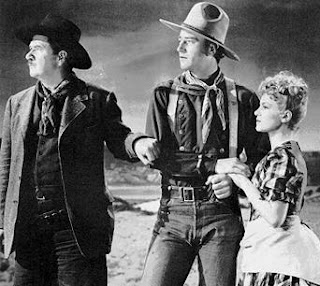 (left)George Bancroft, John Wayne and Claire Trevor
(left)George Bancroft, John Wayne and Claire Trevor John Ford hadn't made a western for a dozen years when he cast John Wayne and Claire Trevor in a story about a stagecoach ride through dangerous Indian territory. The film does not stint on the genre's traditional satisfactions and the last part of the film packs in plenty of action, including a gunfight between Wayne and the Plummer gang and a stirring Indian attack as the stagecoach careers across the flat desert. The sequence was enriched by some superlative stuntwork by Yakima Canutt, who, playing one of the Apache attackers, leaps onto one of the stage's horses, is then shot, and has to fall between the horses' hooves and under the wheels.
This was Wayne's second chance at major stardom after the failure of 'The Big Trail', and he took it with both hands. From hia first entrance, standing in the desert waving down the stage, he cuts an impressive figure as the Ringo Kid, who has busted out of jail in order to be revenged on the Plummers, killers of his father and brother. But Wayne's appearance is delayed while Ford explores the characters of the other travellers on the coach. Each is deftly and memorably sketched in. Dallas, (Claire Trevor), the girl who is no better than she should be, and who is run out of town, together with drunken Doc Boone, by the puritanical ladies of the Law and order League. Peacock (Donald Meek), a timid whiskey salesman; Hatfield (John Carradine), a southern gambler; Mrs Mallory (Luise Platt), the pregnant wife of a cavalry officer; and Gatewood (Berton Churchill), a banker who is making off with the assets. On the outside of the coach are Buck (Andy Devine), the portly driver, and Curly (George Bancroft), the local sheriff. The interaction between this oddly assorted group allows Ford to explore a cherished theme, the superior moral qualities of those whom 'respectable' society disdains.
Stagecoach was the first film Ford shot in Monument Valley, a landscape of towering sandstone buttes on the border between Utah and Arizona. As the tiny c oach makes its way through the vastness of the desert, the frailty of its occupants is doubly emphasized as the camera tracks toward a group of Indians observing its progress. Ford makes no attempt to present the Indians as individuals; they are merely a force of nature. The film's healthy performance at the box office helped re-establish the Western genre and cemented John Wayne's position as a major Hollywood force.
Click here for more on Hollywood's Golden Age movies, actors, actresses and directors





_03.jpg)